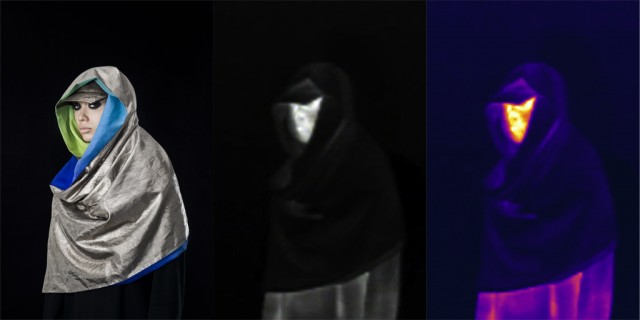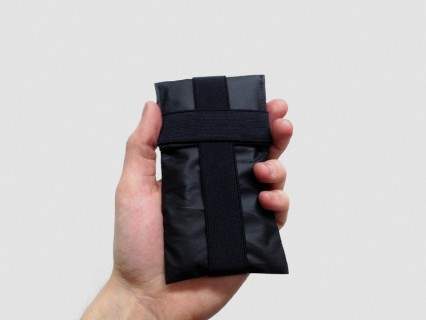 In a move that demonstrates that UAS, facial recognition technology, and cellphone snooping are starting to affect the broader culture, the New York-based artist Adam Harvey has designed a line of high-tech garments made with sophisticated fabrics that can block signals and thwart cameras.
In a move that demonstrates that UAS, facial recognition technology, and cellphone snooping are starting to affect the broader culture, the New York-based artist Adam Harvey has designed a line of high-tech garments made with sophisticated fabrics that can block signals and thwart cameras.
Harvey’s line of “Stealth Wear” clothing includes an “anti-drone hoodie” that uses metalized material designed to counter thermal imaging used by UAS to spot people on the ground.
 He’s also created a cellphone pouch made of a special “signal attenuating fabric.” The pocket blocks your phone signal so that it can’t be tracked or intercepted by devices like the covert “Stingray” tool used by law enforcement agencies like the FBI. And if that’s not enough, Harvey has also made what he calls an “XX-Shirt,” which uses material designed to “protect your heart from X-ray radiation.”
He’s also created a cellphone pouch made of a special “signal attenuating fabric.” The pocket blocks your phone signal so that it can’t be tracked or intercepted by devices like the covert “Stingray” tool used by law enforcement agencies like the FBI. And if that’s not enough, Harvey has also made what he calls an “XX-Shirt,” which uses material designed to “protect your heart from X-ray radiation.”
The 31-year-old artist, who studied mechanical engineering as an undergrad at Penn State, says that the increased use of military surveillance technologies in civilian environments inspired him to create the clothing line. “Military technology is coming home from the war,” he tells me, referring to the growing use of UAS across the United States. “These pieces are designed to live with it, to cope with it—to live in a world where surveillance is happening all the time.”
The clothing range, which also includes an “anti-drone scarf,” is primarily intended to spark a dialogue about the rapid advance of surveillance across society. Though they are pieces of concept art, at the same time they do have a genuine practical use and are being manufactured for public sale. Harvey admits that they’re not cheap, due to the expensive materials involved. The hoodie retails for $487, while the burqa will set you back $2,278. Such is the price of looking good — or invisible. But it doesn’t take a genius to predict that activists and other privacy-conscious individuals will be among his first customers. The “fashionably paranoid market” is his target demographic, Harvey jokes.
The artist’s past endeavours have taken a similar stand against the rise of surveillance technologies. A previous project called “CVDazzle” explored how face-painting and hair-styling could be used to thwart face recognition cameras. He’s not alone in this anti-snooping field, either. Last year, German artist Martin Backes created a counter-surveillance balaclava called “Pixelhead.” Meanwhile, others have tried using DIY methods such as infrared head torches to frustrate the operators of security cameras.
As surveillance becomes more ubiquitous, it seems, we can expect to see increasingly creative and innovative efforts to challenge it coming from all corners of society. Fashion might be most commonly associated with models and catwalks—but it’s a sign of the times that it can now be about UAS and data mining, too.
Source: Slate

Well, the clothing idea is pretty dumb (who wants to walk around looking like that?) but the cellphone pouch is pretty cool, assuming it actually works.